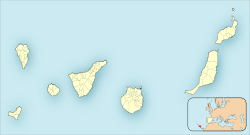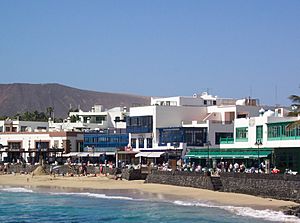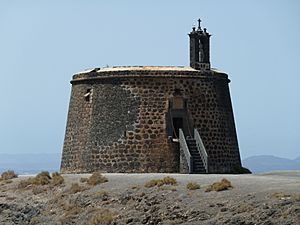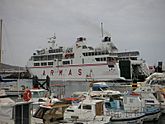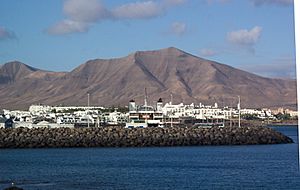Playa Blanca facts for kids
Quick facts for kids
Playa Blanca
|
|
|---|---|
|
Town
|
|
| Country | |
| Autonomous Community | |
| Province | Las Palmas |
| Island | Lanzarote |
| Municipality | Yaiza |
| Time zone | UTC+00:00 (WET) |
| • Summer (DST) | UTC+01:00 (WEST) |
| Postcode |
35580
|
Playa Blanca means "White Beach" in Spanish. It is the southernmost town on the Spanish island of Lanzarote. It is the newest holiday spot on the island. The town is part of the Yaiza area.
Playa Blanca is about a 40-minute drive (45 km) from the airport. It has schools, a notary, and the busy Rubicon Marina. There is also a church and a harbor. From the harbor, you can take ferries to Corralejo on the island of Fuerteventura. A public library opened here in April 2012.
The main bus station is at the northern edge of the town's shopping area. You can catch buses here to all parts of the island. The building also holds the local police station and government offices. In October 2008, Playa Blanca got its own local bus service. The bus goes in a loop around the town, from Faro Park in the west to Las Coloradas in the east. Buses run every half hour.
The coastline around Playa Blanca is a large 9-kilometer-wide bay. This big bay is divided into three smaller bays: Playa Dorada, Playa Blanca, and Playa Flamingo. Because of this shape, the beaches here are calm and great for swimming and sunbathing. The Atlantic Ocean is to the east, west, and south. The land behind the town is flat and volcanic. The main road to Playa Blanca is the LZ2. It heads north from town, then east to the capital, Arrecife. Another important road is the LZ 702 mountain road. It goes northeast from Playa Blanca through Maciot and Femés. People from many countries live in Playa Blanca. These include people from America, Britain, Canada, Germany, Ireland, and Spain.
Contents
Marina Rubicon: A Busy Port
Marina Rubicon is one of the biggest ports in the Canary Islands. It is about a 15-minute walk along the promenade from the town. The marina has 550 places for boats up to 50 meters long. There is also a special area for very large boats up to 90 meters. All boat spots have water and electricity. The marina also hosts markets twice a week, on Wednesdays and Saturdays. You can find handmade gifts and local wines there.
Near Marina Rubicon, you can see the Castillo de las Coloradas. This old watchtower was built between 1741 and 1744. It was built strong and round with a drawbridge to protect the coast. A bell in the tower would ring to warn people when pirates were coming.
The Underwater Museum: Art Beneath the Waves
The Atlantic Museum is a special underwater museum near Playa Blanca. British artist Jason deCaires Taylor created it, and it opened in 2016. The museum has over 300 life-sized sculptures. Most of these are 12 to 15 meters deep in the ocean. The sculptures are made from materials that are safe for the environment. They are designed to help sea creatures grow and live there.
The sculptures cover an area of 2500 square meters. They show scenes from everyday life and also touch on social issues. For example, you can see a woman taking a selfie or a group of people holding hands. The museum aims to connect people with the underwater world in a new way. It also helps protect the ocean by creating new homes for marine life.
You can visit the museum by taking a guided diving or snorkeling tour. This lets you see the sculptures up close. You can also view the museum from a glass-bottom boat if you prefer not to dive. The Atlantic Museum is famous worldwide for its unique idea. It is seen as one of the best attractions in Lanzarote.
Exploring the Beaches of Playa Blanca
In the middle of town is a small beach called Playa Blanca. It has both sand and rocks. This beach is usually the quietest of the three main beaches in the resort. Lifeguards are on duty here. In the evenings, you might see children practicing Canarian Wrestling.
Playa Flamingo beach is about a half-hour walk west along the seafront. Even though it's outside the town center, it has shops and restaurants. This sandy beach is closest to newer areas like Faro Park. In 2005, a big storm damaged Playa Flamingo. The sea wall was rebuilt in 2011. This beach does not have lifeguards.
Playa Dorada means "The Golden Beach." It is to the east of the town center. The water here is very calm because it's in a man-made cove. It's a 10-minute walk from the center of Playa Blanca. There are many shops and cafes nearby. This is the most popular beach for water activities. You can ride banana boats, pedalos, and even try parasailing here. Lifeguards are present at Playa Dorada.
The Papagayo coves are perhaps the most famous beaches around Playa Blanca. These are several smaller beaches separated by high cliffs. This creates many calm, sheltered bays. This area is now a protected national park. You can reach it by a bumpy dirt road, and there's a small fee for cars. You can also walk to the coves from Los Coloradas.
Ferries to Fuerteventura
You have three ferry options to travel from Playa Blanca to Fuerteventura. The Fred. Olsen Express ferry, called the 'Bocayna Express,' takes only 20 minutes. The second ferry is the Naviera Armas 'Volcan de Tindaya.' It makes 7 trips each way daily, and each trip takes 35 minutes. The third option is the 'Princesa Ico Glass Bottomed Boat.'
There has been talk about making the harbor bigger. This would allow it to welcome larger cruise ships. Even big ships like the Queen Elizabeth 2 have visited, but they had to anchor offshore.
Exploring the Surrounding Area
Playa Blanca is overlooked by Montana Roja, a volcano that is no longer active. Walking up and around the rim of the mountain is not too hard. From the top, you get great views of Playa Blanca, the north of the island, and Fuerteventura. Inside the volcano's crater, many people have arranged rocks to spell out names and messages.
To the north and east of Playa Blanca is a protected area called Los Ajaches. This triangular area covers about 3,000 hectares. It includes the mountain village of Femés, the fishing village of Playa Quemada, and the Papagayo beaches. The highest point is the Ajache Grande, at 562 meters. From here, you can see the whole island and Fuerteventura. Los Ajaches was made a "Natural space" in the Canary Islands in 1987. This volcanic landscape is very beautiful. It also has areas with very old fossils from the Pliocene period.
Just a 20-minute drive north of Playa Blanca is El Golfo. The beach at El Golfo is inside a volcano cone that is half underwater. The sea has worn away the volcano over time, leaving only a striped crater wall. At the bottom of the crater is Lago Verde, a green lagoon shaped like a half-moon. Its striking green color comes from volcanic minerals and tiny living things. The beach itself has black volcanic pebbles mixed with pieces of a shiny green mineral called olivine. A large rock finger just off the beach adds to the amazing view. This spot was used to film the 1966 adventure movie One Million Years B.C. El Golfo village is right next to the lagoon. The village has many fish restaurants that serve fresh seafood.
About 8 km north of Playa Blanca is the Laguna de Janubio. This is a large saltwater lagoon. It is home to the Salinas de Janubio, which are salt works. These are the only salt works still operating on the island. In the past, the Salinas produced about 10,000 tons of sea salt each year. Wind power used to pump water into the lagoon, but now electric pumps are used. Most of the salt was used to preserve fish. But with refrigerators, less salt was needed. Today, they produce about 2,000 tons per year. A small amount is sold as high-quality table salt. Every June, during the Corpus Christi festival, tons of colored salt are used to create beautiful decorations in the streets of Arrecife, the capital.
Weather in Playa Blanca
Playa Blanca enjoys sunshine for about 300 days a year. It is located in the eastern Canary Islands, close to Africa. This means it gets little rain. The average temperature throughout the year is around 21°C (70°F).
Because Playa Blanca does not have high mountains, there are few clouds. This leads to less evaporation and comfortable humidity levels. Rain is very rare here. On average, it rains only about 16 days a year. Most of this rain falls between December and February.
February is the coolest month in Lanzarote. The average high temperature is 18.2°C (64.8°F), and the low is 16.6°C (61.9°F). July and August are the windiest months, followed by April and June. In September, the winds usually calm down. During summer, daytime temperatures rarely go above 32°C (90°F). Playa Blanca also has less wind because it is protected by its bay.
See also
 In Spanish: Playa Blanca (Lanzarote) para niños
In Spanish: Playa Blanca (Lanzarote) para niños



